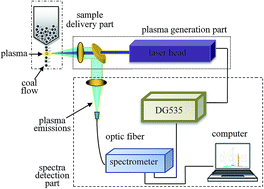Improved measurement of the calorific value of pulverized coal particle flow by laser-induced breakdown spectroscopy (LIBS)
Abstract
The real-time quantitative analysis of the calorific value of pulverized coal particle flow is important for the efficient and clean combustion of coal. Herein, a piezoelectric vibratory feeder produced a continuous flow of pulverized coal particles, which were detected by laser-induced breakdown spectroscopy (LIBS), and the corresponding spectral information was obtained. The obtained data matrices, after removing abnormal data, were subjected to normalization in a row-wise manner to improve the signal repeatability. Then, the second convolution derivative was conducted on the LIBS spectra to correct the spectral interference. To acquire appropriate number and type of variables for the PLS quantitative model, the variable selection methods of genetic algorithm (GA) and synergy interval partial least squares (siPLS) in the quantitative model were analyzed and compared. The results showed that spectral correction could be used to improve the predictive precision and accuracy of the quantitative model based on the full spectrum. The predictive accuracy of the model with variables selected by siPLS was further improved. The minimum average relative error (RE) of the predictive values for the validation samples was 1.53%, and the average error of the proposed model for the calorific value quantitative analysis was 0.22 MJ kg−1. The measurement indicated that LIBS could realize an accurate and precise real-time quantitative analysis of the pulverized coal particle flow.



 Please wait while we load your content...
Please wait while we load your content...